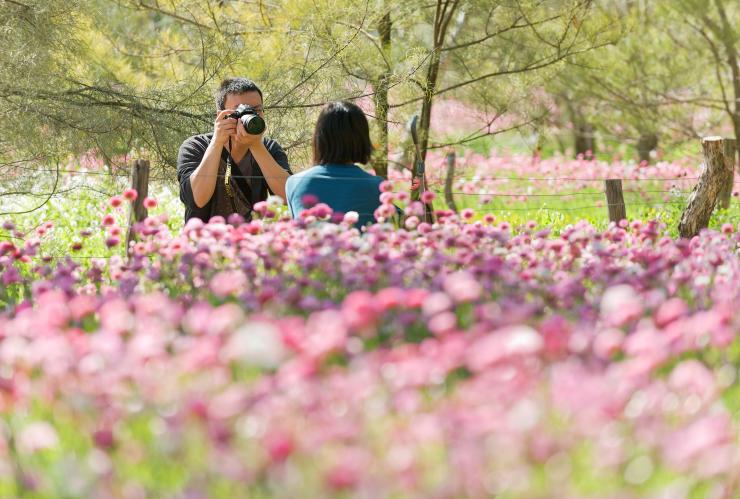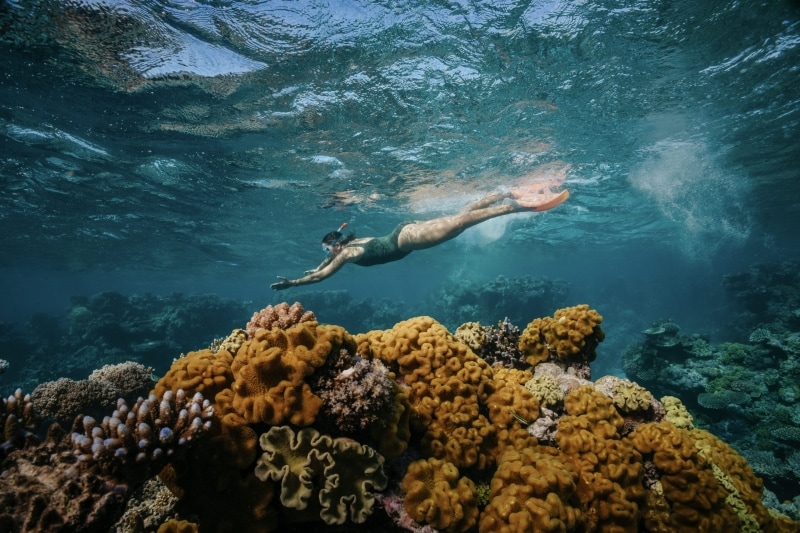
A 10-day trip of colourful attractions
Pink lakes, black flowers and bright yellow moonscapes: Western Australia might be best known for its gorgeous beaches, but this trip will have you seeing the whole rainbow.
By Fleur Bainger
Did you know you can find several bright pink lakes in Western Australia? What about thousands of bright yellow spires, rising from enormous sand dunes? From the deep green of ancient forests to multi-coloured carpets of neon wildflowers, this 10-day road trip will deliver a rainbow-coloured experience.
What to expect
- Colourful carpets of neon wildflowers
- A pink lake the colour of fairy floss
- The Insta-famous Valley Of the Giants
Fast facts
- Time: 10 days
- Distance: About 1800km
- Transport: car, public transport (bus)
- Nearest major city: Perth, Western Australia
- Price: $$
Day 1: Wander through wildflowers right in the city centre

Kings Park Botanic Gardens, Perth, Western Australia © Botanic Gardens & Parks Authority
When you picture the heart of a capital city, you imagine skyscrapers, clogged traffic and billboards, right? Wrong. In Perth's urban core lies one of the largest inner-city parks in the world – and it’s coated in colour. Kings Park is bigger than New York City’s Central Park and each September, many of the state’s 12,000 wildflower species blossom, dotting the grounds in fierce shades of yellow, pink, blue, red, green and even black. Year round, native plants – including a 750-year-old boab tree – fill the urban bush, parting to grant spectacular, elevated views of the Swan River. The annual Kings Park Festival runs throughout September but the wildflowers can often still be seen well into October and free walking tours are offered daily, year-round. Look out for the kangaroo paw, a two-toned plant that resembles its name. Pro tip: the commuter buses along St Georges Terrace in the city centre will take you on the five-minute journey to Kings Park for free – just tell the driver where you’re headed. Bring a picnic rug and join the locals on the lush grass of the Botanic Garden, overlooking a breathtaking city panorama. After walking along the suspended treetop bridge, 52 metres (170 feet) above the forest floor, exit Kings Park and head to South Perth for a sunset with a difference. Witness the peach-hued reflections mirrored on Perth’s city skyline from a glamorous perch at the new rooftop bar at Crown Towers, Hi Line.
Day 2: Photograph weird yellow spires rising from the earth

The Pinnacles, Nambung National Park, Western Australia © Richard Rossiter
Every year, about 50 new species of wildflower are discovered in Western Australia, most of them observed in the dry, flat Wheatbelt region north of Perth. Boisterously colourful, the blooms are found throughout the state – and you’re headed to see them today. Begin your wildflower hunt in John Forest National Park, a 45-minute drive from Perth’s centre to its surrounding hills. There, look carefully for splashes of colour among the grasses and shrubs, and make friends with the resident western grey kangaroos – they’re quite relaxed around people. You’ll soon get the knack for spotting flowers such as banksias, grevilleas, triggerplants and heart-leaf flame peas; some are large, others tiny, and many are intricately detailed, like nature’s haute couture.
Next, drive north for 2.5 hours to the fishing town of Cervantes, stopping along the way to explore the low scrub; you’ll need to get out of the car to track the flowers down. The annual bloom starts half way up the state in late June and, like a slowly curling wave, moves down the map until November, when the last petals disappear at the close of spring. September is the best time to spot them.
Stop in at the popular Lobster Shack for lunch and savour the state’s sublime seafood, then take a tour of the lobster processing facility. Double back along the Indian Ocean Drive to Nambung National Park, home to the eerily extraordinary Pinnacles: natural limestone formations that push up from the yellow sand like weathered spires. Thousands are spread across a wide, bare plain, resembling an alien landscape – you can drive or walk along a trail through them, getting nice and close, with views of the ocean in the background (it makes for fantastic photos). Spend the night in Cervantes.
Day 3: Pose in a sea of pink

Wildflowers in bloom, Turquoise Coast, Western Australia © Tourism Western Australia
Set off in a south-easterly direction towards Toodyay, a country town with character bearing a surprisingly high number of pubs, cafes and antique shops. The journey should take about 2.5 hours; on the way, pull in to Julimar Conservation Park and start hunting for orchids. To wildflower enthusiasts, these are masterpieces, both for their graceful formations and for their rarity – spotting the blooms becomes a game. Continue on to Toodyay and soak in the quirky personality. The town boasts an all-year-round Christmas shop, Christmas 360 and has a 1950s style cafe dedicated to Coca Cola memorabilia – both are worth a look (and the cafe’s milkshakes are good).
Found just outside town, Pelham Reserve in spring often looks as though the ground has been painted pink. The wildflowers creating the very Instagrammable colour are called everlastings and they feel like dry, shiny paper to touch. When winter rains are plentiful, the everlastings carpet the ground, leading to York gum and jam tree woodlands. There are picnic tables beneath the khaki canopy – bring a snack and savour it to the sound of birdsong before travelling the pretty 80 kilometres (50 miles) drive back to Perth.
Day 4: See more shades of blue than you knew existed

Rottnest Island, near Perth, Western Australia © Tourism Western Australia
Feel the thrill of taking off from a watery runway in a seaplane, leaving the Swan River in your wake as you fly past central Perth’s skyscraper frontage to nearby Rottnest Island. The colours shift from the river’s steel-blue to the island’s rim of glass-like turquoise, met by mottled patches of green seagrass, coral gardens and navy. The journey is over all too fast – it only takes 15 minutes to reach Rottnest – but the Swan River Seaplanes experience includes a low-level scenic flight of the island and an all-inclusive, activity-rich day trip. See the sights, learn the (sometimes dark) history, snap a selfie with a quokka – the ultra-cute, grinning Rottnest marsupial – and have a lazy lunch while gazing at crystalline water. Then you’ve got another fabulous flight with an aquatic landing on the Perth side to look forward to.
Day 5: Explore Australia’s only biodiversity hotspot

Koomal Dreaming, Margaret River, Western Australia © Koomal Dreaming
Margaret River is known (and loved) for its wine, its waves and its whales, but don’t overlook its other impressive offerings. Wildflowers push through the forest floor, shooting tiny stars of colour through the green; they decorate the tops of coastal shrubs that move in the maritime breeze and cluster in the branches of tall native trees, showering down fine petals like a fine, sweet-smelling snow. Take yourself on an easy walk of the Cape to Cape Track's northern end – you can choose short sections, and the stretch between Cape Naturaliste Lighthouse and Smiths Beach is rife with wildflowers – or join a fun and informative guided walking tour or an award-winning 4WD tour that includes a wine tasting, and learn more than you ever imagined about Western Australia’s extreme biodiversity. Fun fact: 70 per cent of the state's flowering natives are found nowhere else in the word.
Margaret River is not only full of natural spectacles; it's also brimming with age-old wisdom and cultural wonder. Koomal Dreaming offers unforgettable experiences that leave you with a profound understanding of the water-lapped land. Expect your skin to prickle as the deep warble of a didgeridoo fills the air of the ancient Ngilgi Cave. Feel the pride as you learn the art of fire-making and savour the flavour of kangaroo seared over the flames. From foraging for exquisite bush ingredients to interpreting ancient artifacts within Naturaliste National Park, visitors often describe Margaret River's Aboriginal experiences as 'an awakening.'
Day 6: Stand beneath a 60-metre (196-foot) tall tree

Boranup Forest, Margaret River region, Western Australia © Elements Margaret River
Head south, travelling deeper into the Margaret River region, to where the trees grow taller overhead and the wildflowers dot the ground beneath. Mix in the wildflower spotting with a mountain bike ride through the bush to some of the region’s famous wineries. The Sip n Cycle Winery Tour guides you from cellar door to cellar door on two wheels, cycling in a relaxed fashion to appreciate both the wine and the glorious scenery it’s produced in. The tastings are modest, given you’re handling a bike, so afterwards, you’ll be able to drive to the breathtaking stretch of sky-scraping karri trees known as Boranup Forest in Leeuwin-Naturaliste National Park. The trees – up to 60 metres (196 feet) tall – are distinctive for their pale white trunks, while colour pops from tiny wildflowers lurking beneath. Take the unsealed scenic detour via Boranup Drive and turn your face to the sky.
Day 7: Walk on air beside 400-year-old beauties

Valley of the Giants Tree Top Walk, Walpole-Nornalup National Park, Western Australia © Tourism Australia
The wilderness hotspot of Walpole is a three-hour drive from Margaret River, passing through tall tree forests all the way. Stop at the former milling town of Pemberton for lunch and visit the towering Diamond Tree on the town’s outskirts on your way south – climb up to the fire lookout cabin at the top if you’re brave. Your key destination for today: the oft-Instagrammed Valley of the Giants, where the huge, red tingle trees cluster with wildflowers at their toes. The largest measure 22 metres (70 feet) around the trunk, and they reach 40 metres (130 feet) into the sky, living for some 400 years. Unless you’re afraid of heights, go on the Tree Top Walk, a suspended, see-through walkway leading you through the forest canopy for 600 metres (2,000 feet), and moving in unison with the branches. It’s like walking on air. Afterwards, reward yourself with a pause at Singlefile Wines (try the signature chardonnay), near the pretty coastal town of Denmark.
Day 8: Step off the edge of a cliff

The Gap, Albany, Western Australia © Tourism Western Australia
The Bibbulmun Track stretches for nearly 1,000 kilometres (600 miles) from Perth, and its tail end links Denmark with the neighbouring bayside city of Albany. In the morning, pick any short section and within minutes of stepping into the bush you’ll be seeing those familiar twinkles of colour. The wildflowers here are small and shy, but worth seeking out. Get up close and focus on the fine details – Mother Nature’s artwork makes for excellent macro photography. There are some 8,000 wildflower species in this area; see how many you can find before following the trail eastward to Stirling Range National Park near Albany. Rare orchids love this area, as do some 1,500 other species of native plants, all fringing numerous walking trails.
Afterwards, drive to Torndirrup National Park and get your hair blown back at The Gap, where a viewing platform juts out over a clifftop, granting a pulse-quickening view of the raging ocean below.
Day 9: Marvel at a bright pink lake

Rainbow Lakes, Esperance, Western Australia © Golden Outback
The five-hour drive to Esperance is best broken up with a venture into Fitzgerald River National Park. The UNESCO World Biosphere Reserve is regarded as one of the richest wildflower havens in the world – nearly 20 per cent of Western Australia’s plant species are found here – and it comes alive from September to November. Look for the bright reds and yellows of banksias and bottlebrushes, the hot pink of hakeas, and the delicate fronds of feather flowers. Watch for native animals, too, such as the endangered dibbler – if you’re quiet, you might see one – and head to Point Ann to see whales in the bay. Pull yourself away because the archipelago-facing town of Esperance awaits, and with it, a huge drawcard. The region is home to an abundance of pink and rainbow lakes, ranging from pops of yellow and orange to pastel pink and deep red, contrasting with their grassy borders. Board a scenic flight with Fly Esperance to experience the colourful spectacle from above.
Day 10: See kangaroos on a white sand beach

Lucky Bay, Cape Le Grand National Park, Esperance, Western Australia © Tourism Australia
It’s hard to believe that kangaroos can be found lazing on the beach at Lucky Bay, so best you go and see it for yourself. About 60 kilometres (37 miles) east of town, these iconic animals stand out well against the powdery white sand, which is so pristine that it squeaks when you walk in bare feet along it. The backdrop of transparent blue water only adds to the spellbinding nature of the scene – we guarantee you’ll be snapping as many photos as your memory card can handle. Back in Esperance, walk along the paved track that traces the foreshore then take the short trip to the airport and fly back to Perth.




























































































































,url-https%3A%2F%2Fwww.australia.com%2Fcontent%2Fdam%2Fassets%2Fimage%2Fmapbox%2Fmarkers%2F1x%2F8.png(123.202971,-34.094634),url-https%3A%2F%2Fwww.australia.com%2Fcontent%2Fdam%2Fassets%2Fimage%2Fmapbox%2Fmarkers%2F1x%2F7.png(117.8836,-35.0248),url-https%3A%2F%2Fwww.australia.com%2Fcontent%2Fdam%2Fassets%2Fimage%2Fmapbox%2Fmarkers%2F1x%2F6.png(116.893765,-34.978272),url-https%3A%2F%2Fwww.australia.com%2Fcontent%2Fdam%2Fassets%2Fimage%2Fmapbox%2Fmarkers%2F1x%2F5.png(115.0769,-33.9532),url-https%3A%2F%2Fwww.australia.com%2Fcontent%2Fdam%2Fassets%2Fimage%2Fmapbox%2Fmarkers%2F1x%2F4.png(115.5183,-32.005),url-https%3A%2F%2Fwww.australia.com%2Fcontent%2Fdam%2Fassets%2Fimage%2Fmapbox%2Fmarkers%2F1x%2F3.png(115.038105,-30.306597),url-https%3A%2F%2Fwww.australia.com%2Fcontent%2Fdam%2Fassets%2Fimage%2Fmapbox%2Fmarkers%2F1x%2F2.png(115.155603,-30.603149),url-https%3A%2F%2Fwww.australia.com%2Fcontent%2Fdam%2Fassets%2Fimage%2Fmapbox%2Fmarkers%2F1x%2F1.png(115.8605,-31.9527)/auto/600x400@2x?access_token=pk.eyJ1IjoidG91cmlzbWF1c3RyYWxpYSIsImEiOiJja2ExdXdsNzYwNTZsM2dsd24zNnFqMTN2In0.An2c1t_cPfn8R7-LR5glLg)



